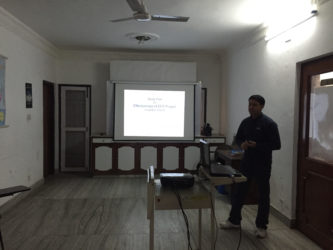




Clear and concise business writing skills and verbal/non-verbal communication skills are a necessity for any business or organization. Unfortunately, employees often devote up to three hours each day struggling to express their thoughts and recommendations in writing. With awkward sentence structure, poor planning, and murky language, their message is lost due to information clutter. Misinterpretation or misunderstandings are inevitable if employees can’t cut through the clutter and communicate clearly.
ALC’s Business Writing and Communication course is structured to teach core elements required to craft a clear message. The course provides ample opportunity to practice writing and receive feedback that will give insight, guidance and encouragement participants need to truly advance their written and verbal business communication skills. The course also encourages team-work and other skills critical to succeed in today’s international work environment. We utilize case studies and involve learners in a variety of task-oriented activities. The case studies reflect the kind of standard business practice that most learners of Business English are likely to encounter in their every day working environment.
Course Overview:
1. Business Email
When information needs to be sent quickly, there is no better way than an email. The problem is with the benefit of speed comes mistakes that are not always predictable unless you are forewarned. The Business email training is designed to help you or your employees know the appropriate use the internet while at work as well as behaviors they must vigorously avoid.
Program Objectives:
- Explain instances when sending email is necessary and appropriate
- Identify occasions when sending or retrieving email is unacceptable
- Understand items they should never send electronically from their workplace
- Create an email subject line that accurately describes the content of the message
- State and avoid 12 of the most common mistakes people make in business writing
- Consider the visual components that enhance an email message and make for easy reading
- Determine who should and should not receive copies of emails
- Know what to do when emails misfire and reach the wrong people
- Develop a personal action plan to improve their email skills at work
2. Business Writing
For anyone whose job responsibilities include frequent writing about issues for a variety of readers, the task in never easy. Poor writing and bad grammar, vocabulary or punctuation can stall or sink a successful career. Don’t let this happen to you or the member of your team. Business writing tackles everything from basic usage to editing techniques, under guidance of an instructor with years of professional experience. This part of the course is interactive, fast paced, fun and full of tips and techniques you can use immediately.
Program Objectives:
- Identify the “bottom line” in a writing task
- Understand the connection between audience awareness and a writer’s style
- Arrange information in a logical sequence
- Write clear and concise sentences
- Eliminate the passive voice, wordiness and redundancy
- Use correct punctuation and grammar
- Minimize words, sentence, and paragraph length without sacrificing clarity or substance
- Quickly proofread and edit a piece of writing
- Define the 5 Cs
- Apply proofreading skills to correct mistakes
3. Memo Writing
Memos are one of the most common types of business communication. Memos resemble letters in that they communicate information and are commonly used in the world of business writing. However, memos differ from letters in purpose, content and audience.
Program Objectives:
- Understand the role of the sender, receiver, message, and medium in the context of the memo
- Anticipate and circumvent limitations on memos as a type of push communication
- Understand when sending a memo would less effective than communicating in another way
- Identify various security threats to memos sent through e-mail and know how to mitigate these threats
- Structure and format and your memo to increase readability
- Represent information in your memo in the most appropriate format for the type of data
- Appropriately use the different fields of a memo
- Identify the purpose of your memo
- Understand how writing with a professional tone can make your memo more effective
- Revise your memo to maximize concision
4. Reports and Proposal Writing
The Report and Proposal Writing program is designed for those who need to write comprehensive reports and proposals.
Employees and Office Administrative Staffs need to make informed decisions. And those decisions often swing on the strength of a report or proposal. So, like it or not, reports and proposals are a necessary part of business these days.
Many people are defeated by the awesome task of writing. They do not trust themselves to use written language effectively. They go to the files to see what has been done in the past. To overcome their insecurity, they try to write to impress by hunting for “big” words. They also pad their reports as proof of their thoroughness. Unfortunately, such tactics prevent writing that is clear or concise.
But here’s the challenge. The demand for well written business documents far exceeds the number of people trained to write them.
Our Report and Proposal Writing program meets that challenge head on. We’ll show you simple ways to produce persuasive, clear, well written documents.
Program Objectives:
- Explain the value of good written communications
- Develop paragraphs that introduce, connect, develop, and conclude some part of an idea
- Prepare reports and proposals that informs and persuade
- Proofread work so it is clear, concise, complete and correct
- Apply their knowledge to real workplace writing tasks.
- Local and international trends in report and proposal writing
- Why the business world is now trying to simplify reports
- Taking a reader-centered approach
- Concept to construction-a practical guide to report-building
- How to produce a powerful one-page executive summary
- Why knowing how to self-edit is a must for anyone writing a report
